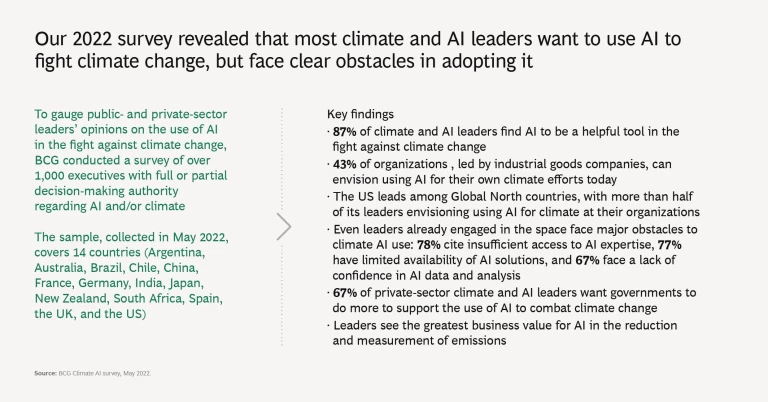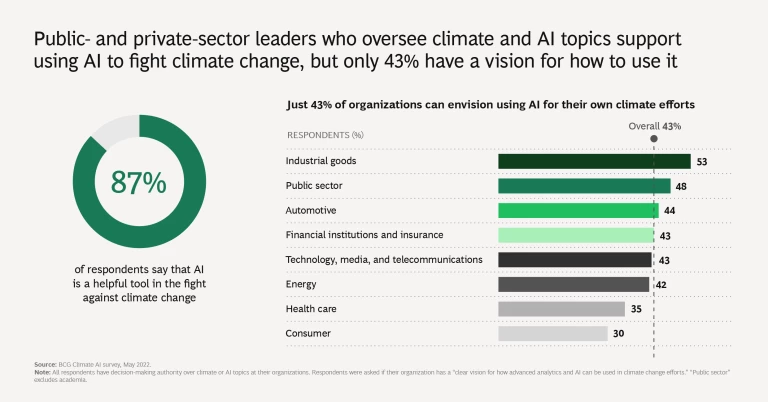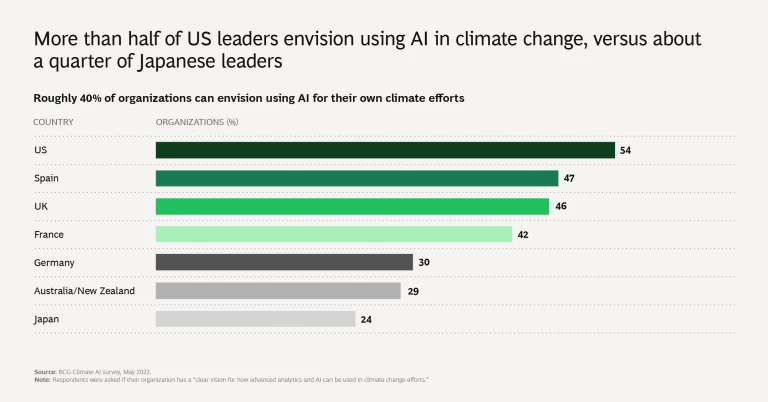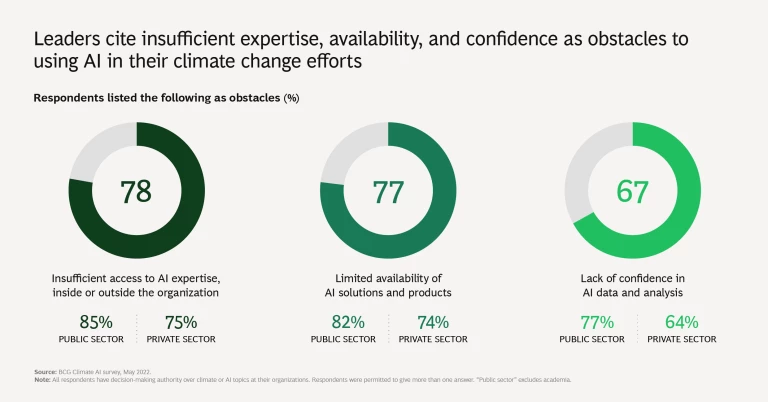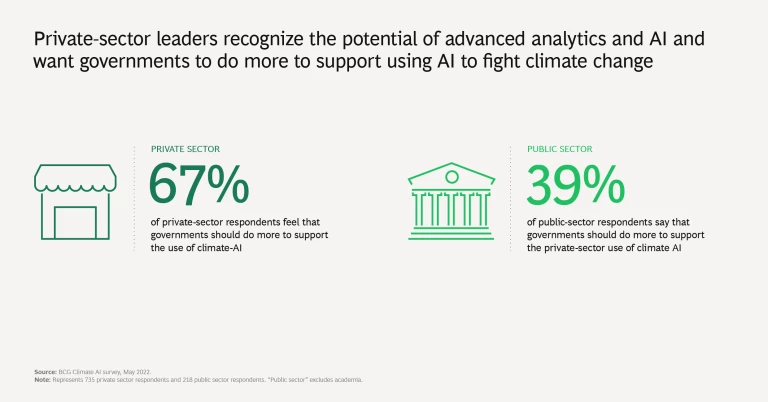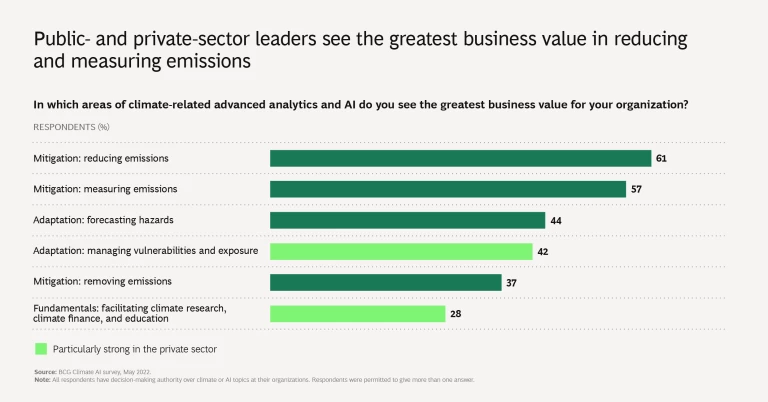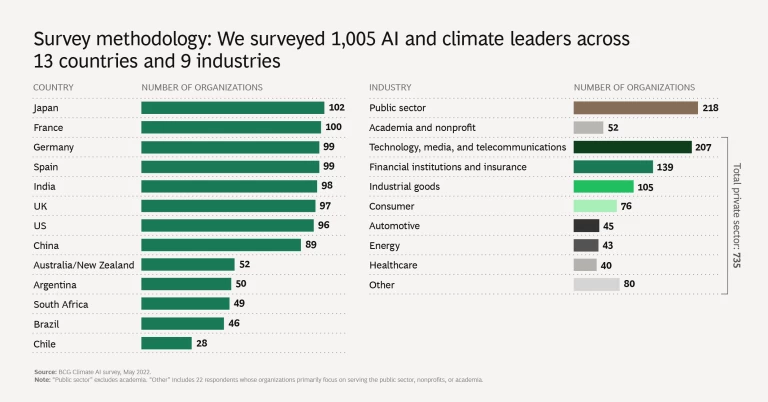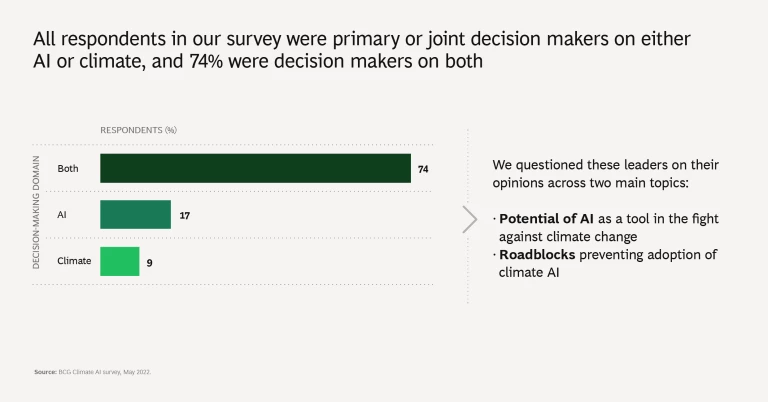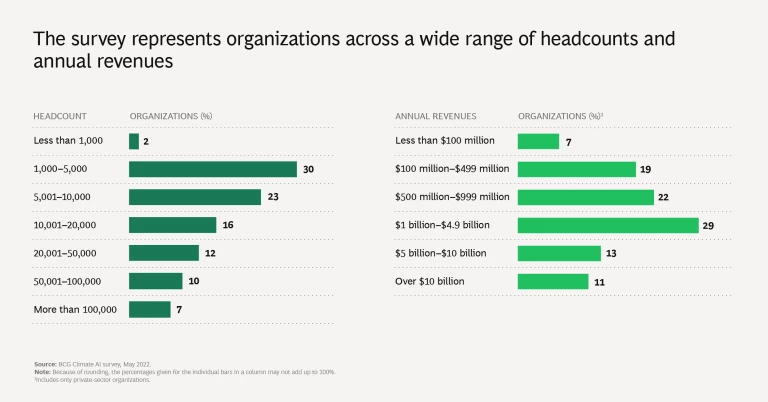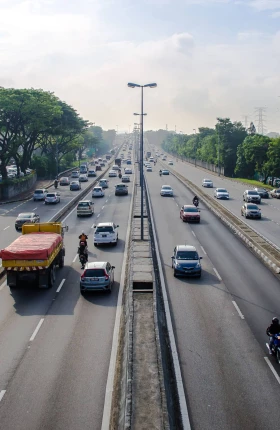The changing climate will have a major impact on environmental, social, and economic systems around the globe. We are already experiencing many of its environmental effects, from longer droughts to more destructive storms.
Mitigation is therefore critical, including efforts to achieve net-zero emissions by 2050. However, minimizing the harm will also require increasing our efforts at adaptation and resilience—from immediate crisis response to long-term planning. Further, these efforts will require support from activities such as research, finance, and education.
AI as a tool is uniquely positioned to help manage these complex issues. Due to its capacity to gather, complete, and interpret large, complex datasets on emissions, climate impact, and more, it can be used to support all stakeholders in taking a more informed and data-driven approach to combating carbon emissions and building a greener society. It can also be employed to reweight global climate efforts toward the most at-risk regions. (See “Addressing the Needs of the Global South.”)
Addressing the Needs of the Global South
Yet, climate change efforts are currently neglecting the needs and priorities of these areas of the Global South. One reason is the lower concentration of wealth and resources there, such that it lags the Global North in adaptation and resilience. Another is that AI research is predominantly run out of research institutes and corporations in the Global North. Even among AI solutions that emphasize the UN Sustainable Development Goals, in fact, over 80% are from the Global North, per the International Research Centre on Artificial Intelligence.
Not only does this focus on the Global North risk the creation of blind spots in AI research and development, but it prevents promising AI solutions from being applied in the contexts where they are most needed. As Sally Radwan, former artificial intelligence advisor to the Egyptian Ministry of Communications and Information Technology, explains, “Models designed and optimized for Global North countries do not necessarily apply well to specific conditions in other countries.”
As a planet, we cannot afford to continue along this path, developing solutions that do not address the needs of the Global South or improve the lives of the billions living there. Instead, AI research and development must ensure that the solutions developed are relevant for the priorities of public- and private-sector leaders and populations in the Global South.
In addition, these regions must be given access to the relevant solutions, along with the capacity building to train those who use them, if we are to ensure that the solutions are put into practice. “The best approach is to build capacity in different regions,” Radwan adds, “helping countries develop models that work in their local context and exchanging knowledge and learnings informed by local expertise.” This may mean bridging gaps in data availability and making solutions designed for a high-data-availability environment work in a context with less data.
We also need to make global resources available to AI solutions developed in the Global South to ensure that those projects reach their full potential. Similarly, connecting projects developed in the Global North to practitioners and users in the Global South is a crucial step if we want to ensure that their solutions meet everyone’s requirements.
As such, the use of AI offers an opportunity to make meaningful change in this critical moment, whether through mitigation, adaptation and resilience or by supporting the fundamentals of overall climate efforts.
With this opportunity in mind, BCG recently surveyed global public- and private-sector climate and AI leaders about their views on the potential of AI as a tool in the fight against climate change as well as the roadblocks that prevent its adoption. (See “Survey Methodology.”)
Survey Methodology
The sample, collected in May 2022, covered 14 countries: Argentina, Australia, Brazil, Chile, China, France, Germany, India, Japan, New Zealand, South Africa, Spain, the United Kingdom, and the United States. Respondents represented organizations from both the public and private sectors with at least 1,000 employees or at least $100 million in annual global revenues.
In response, 87% replied that advanced analytics and artificial intelligence, or simply “AI”, is a helpful tool in the fight against climate change today. In addition, 67% of those in the private sector stated that they want governments to do more to support the use of AI in fighting climate change. (See the slideshow.)
Further, 43% of organizations say that they have a vision for using AI in their own climate change efforts—confirming high interest in the potential of this tool. Note that the percentage differs among industries, ranging from over 50% for industrial goods companies to 30% for consumer companies. Geographically speaking, the US shows the highest interest among Global North countries, with 64% of respondents reporting the use of AI in their climate efforts, while an average 42% say that they have a vision for using it.
Note that we employ the term “AI” to refer to artificial intelligence and advanced analytics, defined as the use of sophisticated data analysis techniques such as machine learning algorithms and data engineering.
The AI Opportunity
Global public- and private-sector leaders surveyed see the greatest business value for AI in the reduction and measurement of emissions. However, there are many diverse ways in which global leaders can use AI to achieve their goals.
- Mitigation. AI can be employed to help measure emissions at both the macro and micro levels, reduce emissions and greenhouse gas (GHG) effects, and remove existing emissions from the atmosphere. In BCG’s experience, for example, AI can be used to help reduce GHG emissions equal to 5% to 10% of an organization’s carbon footprint, or a total 2.6 to 5.3 gigatons of CO2e if scaled globally.
- Adaptation and Resilience. AI can be applied to improve hazard forecasting for regionalized long-term events, such as sea-level rise, and for immediate, extreme events, such as hurricanes, among other possibilities. These applications include the management of vulnerability and exposure, such as by developing infrastructure that can minimize the impact of climate hazards.
- Fundamentals. AI can also be used to bolster efforts across climate research and modeling; climate finance; and education, nudging, and behavior change, such as by powering personalized tools to estimate an individual’s carbon footprint or making recommendations for environmentally friendly purchases. (See the exhibit.)
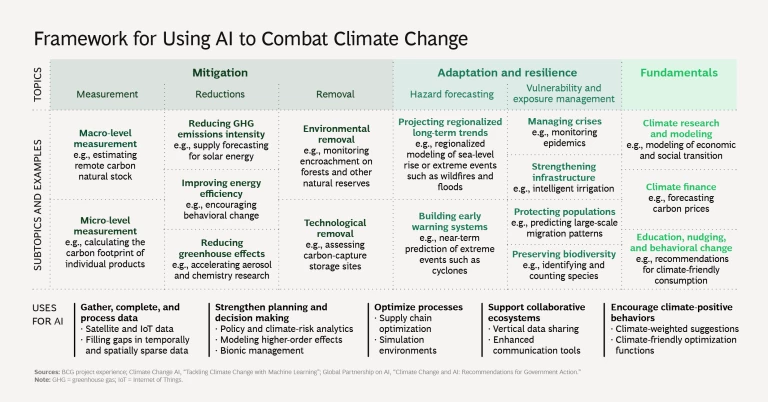
Within each of these uses, AI can be employed in five leading ways:
- To gather and complete complex datasets on emissions, climate effects, and more
- To strengthen planning and decision making
- To optimize processes
- To support collaborative ecosystems
- To encourage climate-positive behaviors
It can therefore serve as a tool for helping stakeholders—from businesses and governments to NGOs and investors—take a more informed and data-driven approach, while offering them opportunities to create meaningful change in this critical moment. Note that AI is not the solution itself, but a tool to help leaders and citizens make informed judgments about how to tackle climate challenges.
Obstacles to Progress
While there are some areas where AI solutions are well-established and ready for broad application—such as emissions measurement and the monitoring of natural carbon sinks—existing AI-related climate-change solutions today are more typically scattered, difficult to access, and lacking the resources to scale.
In addition, not all organizations are yet actively engaged in climate and AI topics, while even leaders already engaged in this space face many obstacles to climate AI use. In fact, 78% of those surveyed cite low access to AI expertise, whether inside or outside their organization, as an obstacle; 77% report a lack of available AI solutions; and 67% say they face lack of organizational confidence in AI data and analysis.
Need for Meaningful Support
If they are to achieve widescale adoption, AI solutions need to be designed for user friendliness, regardless of whether they are developed for corporations, governments, or the general public. They need to be easily accessible, offer tangible benefits to the user, and provide clear information to guide user action.
- Resources and Networks. Promising solutions also need resources and networks if they are to maximize the potential of AI in addressing climate change, particularly in the Global South. They need access to capital investments, decision makers, and trained practitioners, allowing them to be deployed at scale. Financial support can bridge the gap between academic research and at-scale deployment, while connections to policymakers and corporate leaders can help boost awareness and adoption. In addition, sharing knowledge on best practices and promising applications can ensure that solutions are ready for widespread government and corporate deployment. All such resources and networks are especially valuable for solutions that address the needs of the Global South.
- Capacity Building. Successful solutions require extensive capacity building. Training and reskilling can ensure that civil servants, private sector leaders, and other stakeholders use and interpret AI solutions effectively in the most critical contexts. A willingness to overcome vendor lock-in is also required to ensure that promising solutions can be scaled. And today’s AI research—predominantly run out of institutes and corporations in the Global North—needs to become more inclusive, as it risks neglecting the needs of the Global South, where many countries will be disproportionately affected by the changing climate.
- Confidence and Trust. Given its complexity and the risks of unethical behavior, whether intentional or unintentional, users of AI need to earn the confidence of climate leaders. Solutions must therefore use AI responsibly, employ granular and reliable underlying datasets, and emphasize results that can be interpreted and understood.
Despite its promise, we note that AI cannot be used to solve the climate crisis in isolation. Rather, it is one of many tools that should be employed to address this global challenge. Individuals, communities, and organizations who have a part to play in combating the climate crisis—regardless of their formal role in AI or climate topics—should therefore consider how other emerging technologies can help and assist in removing obstacles to scale for those as well.
A Call for Solutions
While there are still numerous roadblocks to implementation, we are excited to work with AI for the Planet to help new solutions push past those roadblocks and achieve their potential at scale. We encourage all interested parties to participate in our first call for solutions—including those at any stage of maturity, given a working prototype, and from any sector.
Recognizing that all individuals, communities, and organizations have a role to play regardless of their formal role in AI or climate topics, readers are further invited to consider how other emerging technologies can help fight climate change and to remove obstacles to scale for those as well.
Finally, we encourage readers who are engaged in the climate or AI communities to share the roadblocks, frictions, and pain points they face in engaging with climate analytics, AI solutions for the climate crisis, and other issues. This vital support will inform future publications and, more importantly, help us prioritize our efforts to address these pain points.
This article is adapted from a report created with AI for the Planet, an alliance created by Startup Inside with BCG as a knowledge partner and in collaboration with the United Nations Development Programme (UNDP); the United Nations Educational, Scientific and Cultural Organization (UNESCO); and the UN Office of Information and Communications Technology (OICT), and includes additional results from BCG’s survey of global leaders.

